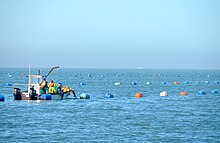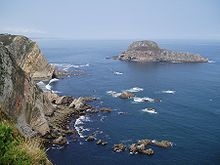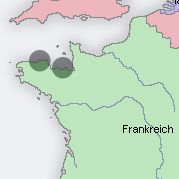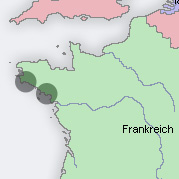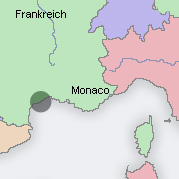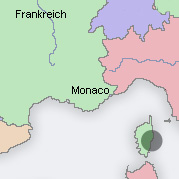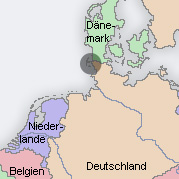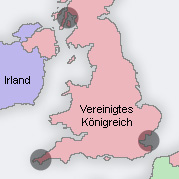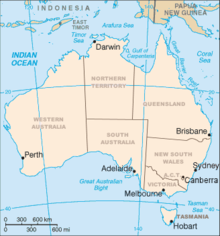Oyster farming
Under oyster farming (ger .: oyster culture , French .: ostréiculture ) refers to the commercial cultivation of oysters in aquaculture . For general information on this type of shell, see Oysters .
General

Oysters live in the intertidal zone of many seas. Traditionally, these oyster beds were fished with drag nets, and the mussels were occasionally retrieved by divers. At low tide , oysters can occasionally be collected with dry feet, for example in the Blidsel Bay on Sylt (Germany), where holders of fishing licenses are allowed to collect ten liters of oysters per day.
Since oysters are a popular food , there was severe overfishing as early as the 18th century . In the 20th century, environmental pollution and the occurrence of viral diseases contributed to a further thinning of the population. As a result, oysters are now mainly grown in controlled aquaculture. Globally, 95.8% of all oysters come from farms; only 4.2% are traditionally fished (2003).
history
In the early days, oysters were collected in the intertidal zone or were salvaged by divers. From the 4th century BC One began in Greece with targeted oyster farming. It was discovered by chance that oysters like to stick to pottery shards and subsequently sank large quantities of them into the sea. The fact that the location has an influence on the taste of the oysters was recognized and exploited by the Greeks.
In ancient Rome the technique of cultivating oysters was further developed and refined. Usually young oysters were collected in the sea and then reared in suitable bays. A Roman representation (see picture on the right) shows a scaffolding under the word “Ostriaria”, from which sacks filled with oysters probably hung into the water. “Brand names” already appeared in Roman antiquity. A certain Gaius Sergius Orata produced oysters in Lake Lucrin , which he brought onto the market under the trade name "Calliblephara" and which were considered to be of particularly high quality.
After the fall of the Roman Empire, the technique of cultivating oysters seems to have been forgotten; it was not rediscovered until the 19th century. In the Middle Ages and early modern times , stocks of wild oysters were only collected, later fished with boats and scrapers and (less often) with rakes. The French city of Cancale was of particular importance; oyster fishing was carried out here on a large scale. The goods were transported by ship along the coast and across the Seine to Paris .
From 1720 the overfishing of the oyster beds became noticeable and an increasing problem. In 1750 oyster fishing in the Arcachon Basin ( Bassin d'Arcachon ) was banned for three years. In 1759, oyster fishing was banned across France from May to October. Further ordinances followed in 1766 and 1787, after which the oyster stocks recovered a little. By 1840 oyster production in Cancale peaked .
In the 1850s, oyster cultivation was resumed in France. Thousands of roof tiles were sunk in the sea after it was found that oysters were particularly prone to clinging to them. Jean Victor Coste studied the breeding techniques of antiquity and suggested various cultivation methods. Such measures were usually supported by the French kings, who were mostly great oyster lovers.
Traditionally, the native European oyster was bred or fished all over Europe . In the 19th century, the oyster species Crassostrea angulata was introduced to Portugal from the Far East . This type of oyster, which is very similar to today's Pacific rock oyster, reproduced rapidly and was used commercially. In 1868, a ship loaded with these oysters sought shelter from a storm for several days in the Gironde estuary near Bordeaux . Due to this delay, the captain mistakenly assumed that the cargo was already spoiled and had the 600,000 oysters thrown into the sea. These "Portuguese oysters" spread rapidly along the entire Atlantic coast. By 1900 this species already accounted for half of French oyster production.
From 1920, longline farming was developed in Japan , which also enables oyster cultivation outside the intertidal zone. In the 1970s, this technique was also introduced in Korea and the People's Republic of China , which led to a sharp increase in oyster production.
The winter of 1962/63 turned out to be the coldest winter in Europe since meteorological records began; even the Grand Canal in Venice had ice floes. The coastal waters of Northern Europe were frozen over for weeks, and many oyster cultures were destroyed as a result. This was the beginning of the decline of the European and Portuguese oysters.
Between 1966 and 1973 the stocks of the Portuguese oyster initially perished due to a virus epidemic ( maladie des branchies ). As a tradition in France, the modern Pacific rock oysters are still occasionally referred to as portugeses ( incorrect ), but the Portuguese oyster is no longer cultivated.
In the 1970s, stocks of the European oyster were severely reduced by two epidemics, first by a disease called Marteilia refringens and from 1979 by Bonamia ostreae . The European oyster industry threatened to collapse. The problem was solved by importing the Pacific rock oyster from Japan, which is resistant to European diseases to this day and has enabled oyster production to grow again.
Cultivation with seed oysters
Female oysters spawn in summer, with each animal producing several million eggs. Oyster farming often does without this natural reproduction; instead, the stocks are built up with seed oysters. In fact, in northern areas this is absolutely necessary, as oysters do not spawn reliably in cool water.
Seed oysters (English: late , French: naissain ) can be grown in the sea or in the laboratory. When reproducing in the sea, a suitable subsoil must first be found, as oysters tend to stick to hard objects. Since oyster larvae particularly value roof tiles, large quantities of limed roof tiles are often sunk into the sea on farms at the beginning of summer. As soon as they have grown on the bricks, they are taken out of the sea and the oysters are carefully peeled off and sold. Alternatively, seed oysters can also be raised in laboratories under controlled conditions in tanks or basins.
Triploid oysters
Triploid oysters have three sets of chromosomes and are therefore unable to reproduce. They arise from eggs fertilized with tetraploid sperm. Their meat remains unaffected by reproductive processes such as the production of eggs in summer. Triploid oysters grow faster and, in contrast to normal diploid oysters, have about the same quality all year round. Triploidy does not represent a change in the genes. The entire set of chromosomes is present three times instead of two times.
Types of Cultivation
Soil cultivation
Soil cultivation is the simplest and cheapest form of oyster farming. The oysters are sown over suitable subsoil. After three to six years, they have grown to a size ready for sale and are brought in with scrap nets. This method is common in Europe, especially in England, for breeding the European oyster .
The main advantage is the low effort and therefore low costs. No work is required between sowing and fishing. Furthermore, this method does not require any space on the surface. Disadvantages are the ecological disturbance of the seabed by the mining nets and the introduction of unwanted bycatch . Another problem is that - in contrast to the other methods - seafaring is possible in the area of oyster farming . Ships and boats sailing over the oyster beds can lead to water pollution.
Table cultivation

The table cultivation is only possible on flat coasts with a sufficiently wide tidal zone. With this method, about 50 cm high iron tables (French: tables à caire-voie ) are set up in the tidal zone . Coarse-meshed sacks (French: poches ) lie on top of these , in which the oysters grow. You are in the water at high tide and dry at low tide. Rearing them on tables prevents the oysters from taking on a muddy taste and continues to protect the animals from predators living on the ground. The bags are shaken and turned at regular intervals so that the oysters do not grow together or get a crooked shape, and the algae growth must be constantly removed.
The main advantage of table cultivation is that constant care gives the oysters a nice-looking shell. This is particularly important when they are sold as "slurp oysters". The method is therefore predominant in France . Another advantage is the fact that cultivation can be done with dry feet at low tide.
The disadvantage is the large area required for oyster farming and the high workload. Table culture oysters are therefore relatively expensive. In northern regions ( Germany , Great Britain , Ireland ) ice rushes can be a problem in winter, the oysters then have to be overwintered in sheltered basins.
In some regions table cultivation is combined with soil cultivation. The baby oysters first grow on a suitable substrate on the sea floor and are only collected when they reach a certain size and then grown in sacks.
Linen cultivation
In longline cultivation , a suitable substrate - often pierced mussel shells - is woven into a plastic or steel cable so that there is a shell on the cable every 20 cm. The bowls are often held at a distance by 20 cm long plastic tubes. The oysters grow on these mussel shells.
In vertical cultivation, the lines are hung from rafts or buoys into the water. With the horizontal method, the lines - often more than 100 meters long - are stretched horizontally between pegs. Diagonal cultivation is less common, here the lines in front of the top of a post are led diagonally like the lines of a tent to the seabed and anchored there.
When the oysters have reached the desired size, the lines are brought in and the animals are detached from the substrate. Linen cultivation is widespread in Asia, and experiments are now being carried out in Europe, especially in the Bassin de Thau (France) and Ireland.
Linen cultivation can also be used in areas where there are no shallow tidal zones. In addition, the space required is less than with table cultivation, as the third dimension of the sea is used. The disadvantage is that cultivation cannot take place in the dry.
Raft cultivation

Raft cultivation is similar to linen cultivation, but the oysters are not pulled on lines, but in sacks or boxes that are hung from a raft into the water. This enables an even greater crop density than with line cultivation, and the workload is less. They are used in nutrient-rich bays, but also on the open sea. However, the oysters often develop an unsightly shell in the narrow containers. This is of no importance in Asia, as usually only the meat of the oysters is sold. The method is less suitable for breeding "slurp oysters".
As a result of the further development of this process, many horizontal intermediate grids were drawn into the cages with a small gap between them. This gives you a lot of space to lie on, on which the oysters are spread as a thin layer. The rafts were deployed through buoys that are lined up on an anchored main line. The tubular "lantern net" developed in Asia also has many grid floors and is therefore a replacement for the cages. The lantern net is now available in different versions, each tailored to the seafood to be cultivated, including oysters.
Finishing
The "meat oysters" from linen or raft cultivation can be processed or sold immediately after harvest. A refinement is customary for culinary "slurp oysters" and is mandatory in some countries. In Great Britain, for example, oysters have to be cleaned for at least 42 hours in tanks whose water has been sterilized by UV radiation.
In other countries - especially in France - post-treatment is used to refine the taste ( affinage ). The oysters are cleaned in clarifiers ( claires ) for a few weeks or months so that any muddy taste disappears. They are then sold as “ fines de claire ” , and after a particularly long period of clarification, also as “ spéciales de claire ” . Oysters that are sold directly from the oyster parks without any clarification are called " huîtres de parc " .
After clarification, French oysters are not infrequently placed “in the fresh air” ( au grand air ). They come in pools in which water is taken in and out at irregular intervals. Oysters grown in table cultivation normally open at high tide and close again at low tide. The animals are trained to keep this steady rhythm so that they do not open their shells during shipping in the dry.
Oyster farming worldwide
Spain
With an oyster production of around 3,100 tons (2003), Spain ranks fourth behind France, Ireland and the Netherlands. The value of oyster production is around 7.5 million euros per year. It is noteworthy that the majority of production (2,400 tons, 2003) comes from the European oyster (Ostrea edulis) - making Spain the world's largest producer of this oyster species. The Spanish oysters are mainly consumed in the country, small amounts are exported to Italy .
France
About 125,000 tons of oysters were produced in France each year. On a European scale, France is the most important country of origin for oysters; 88% of all oysters consumed in Europe come from there. In a global comparison this is put into perspective, France's share of world production is only 2.5%. Since oysters in France are traditionally eaten at Christmas time, almost half of the annual turnover occurs in December (60,000 t).

In France, oysters are almost exclusively marketed as fresh (live) goods. Canned oysters or oyster derivatives are rarely produced. The Pacific rock oyster (Magallana gigas) accounts for around 99% of production. The European oyster (Ostrea edulis) is a niche product; the annual production is around 1,000 tons. The vast majority of oysters are self-consumed in France. Around 6,500 tons are exported, two thirds of which (4,260 tons) to Italy (2005). In the export statistics, Belgium (650 t), Germany (390 t) and Switzerland (220 t) (2004) follow at a considerable distance . France imports around 6,600 t from abroad, 3,400 t from Ireland and 1,400 t from England . A portion of these imports is above the deli - wholesale re-exported again.
With regard to the cultivation of oysters, France is divided into eight regions, whereby Corsica is usually forgotten in the literature.
Normandy
In Normandy , the strongest prevail tides of Europe, the tidal range is up to 14 meters, and at low tide the sea pulls back to six kilometers up. The conditions here are very favorable for oyster production. On an area of 1,200 hectares, 27,000 tons of oysters are produced each year (2004), making Normandy the second most important region in France after Poitou Charentes in terms of quantity . Almost all of the production is accounted for by the Pacific rock oyster ( creuse ), the European oyster ( plate ) is almost extinct. Despite their economic importance, Normandy oysters are little known, even in France. The oyster cultures extend almost along the entire coast, from the Belgian border to the border with Brittany , near Mont-Saint-Michel . The Cotentin peninsula , the area south and east of Cherbourg, is particularly important .
Northern Brittany
As in Normandy , the tides in Brittany are very strong; the intertidal zone is very suitable for oyster farming. For some time, however, oysters have also been grown in deeper water. 22,000 tons of oysters are produced every year; mainly the Pacific rock oyster. Most of the French plates (800 t) are produced in northern Brittany . There is oyster farming along the entire north coast, from Brest in the west to the Normandy border at Mont-Saint-Michel .
South Brittany
The south coast of Brittany is rugged, numerous rivers and streams drain into the Atlantic and bring valuable nutrients with them. The conditions are therefore very favorable. Oysters are grown both in the intertidal zone and in deeper water. The annual production is 21,000 tons (2004) of the Pacific rock oyster and an additional 200 tons of the European oyster. Breton oysters are very popular. The “ creuses ” from the Rivière d'Etel , the Quiberon peninsula and the Gulf of Morbihan are particularly valued . The most famous oyster farm in Brittany is located at the mouth of the Bélon River , south of the city of Pont-Aven . In addition to normal Pacific rock oysters, European oysters ( plates ) are bred here.
Pays de Loire
On the Atlantic coast south of the Loire estuary, 9,000 tons of oysters are produced annually; almost exclusively Pacific rock oysters. The production extends in the north from the Loire estuary to the Bay of Bourgneuf , on the coast of the opposite island of Noirmoutier , and in the south on the coast at L'Aiguillon-sur-Mer . The oysters are known as " Huîtres Vendée Atlantique " and " Huître Pertuis ". They are mainly consumed locally.
Poitou Charentes
In this sector of the Atlantic coast there is the most important oyster production in Europe in terms of volume. The annual production is 30,000 tons of the Pacific rock oyster (2004). The Poitou Charentes region stretches from La Rochelle in the north to the mouth of the Gironde and includes the island of " Île de Ré ". In this region, the most important oyster farm in France is located in the sub-region "Marennes-Oléron ". This includes the Atlantic coast from Port-des-Barques in the north to Ronce-les-Bains in the south (" Côte Atlantique ") and the east coast of the island of Oléron in the area of Château-d´Oléron (" Ile d´Oléron côte est " ). To the south of Marennes there are a large number of clarifiers ( claires ) in the bay of the Seudre river (" Vallée de la Seudre " ). The oyster farm in Marennes-Oléron covers 2,500 hectares of oyster parks and 3,000 hectares of clarifiers. 450 companies are engaged in the rearing of oysters, 700 in the processing. The region's annual turnover is around 200 million euros. The nutrients for the oysters are supplied by the Charente and Seudre rivers, among others . The microscopic alga Navicula ostrearia is often found here, it gives the oysters in the clarifier a characteristic emerald green color (“ Fines de claires verte ”). Particularly high-quality oysters are offered as " Label Rouge ". Another specialty are the oysters from Gerard Gillardeau , which are coveted by gourmets . Naming the oyster farmer by name is very unusual, as seafood is usually marketed without naming the producer.
Arcachon
In this southern part of the French Atlantic coast, 350 companies produce 9,000 tonnes of oysters per year (2004), excluding the Pacific rock oyster, which is marketed as " Huître Arcachonnaise ". Oyster cultures can generally be found along the entire coast from the Gironde estuary in the north to the Spanish border in the south. The center of oyster farming is located in the Bay of Arcachon , 50 km southwest of Bordeaux . The importance of this region lies less in the production of finished oysters than in the rearing of young seed oysters. In the pure and relatively warm waters of the Arcachon Bay , young oysters develop better and more reliably than in the cooler north. The Arcachon seed oysters are removed from the substrate and marketed when they are eight to ten months old. At this age they are around two inches tall. These oysters are supplied to the breeding parks in northern France and Ireland, which are heavily dependent on supplies from Arcachon .
Mediterranean Sea
The majority of all French oysters come from the Atlantic , but a small part (10,000 t) come from the Mediterranean (2004). Oyster farming is concentrated in the area between Béziers in the west and Montpellier in the east, and especially in the Bassin de Thau . This salt water basin covers 7,500 hectares and is supplied with nutrient-rich fresh water from various tributaries. The Pacific rock oyster is produced. Since the tides in the Mediterranean are much lower, the oysters are not cultivated here in the tidal zone, but in deeper water. They grow on mussel shells that are attached to ropes or nets and hang into the water from rafts. The most sought-after oysters come from the small community of Bouzigues on the north bank of the Étang de Thau as well as those from the localities of Mèze , Marseillan and the port city of Sète .
Corsica
Napoléon Bonaparte was - as a local patriot - a great lover of Corsican oysters, he ordered deliveries twice a week. Today oyster production in Corsica is of little importance. The Pacific rock oysters are mostlydrawnfrom Arcachon seed oysters. The oyster parks can be found on the east coast of Corsica. The oysters from the Bay of Étang de Diane are valued for their hazelnut flavor. There are other oyster cultures in the bays of Étang d'Urbinu and Étang de Biguglia .
Belgium
Oyster fishing in Belgium can be traced back to 1733; it largely came to a standstill in the 20th century. In the Ostend area, there is now a smaller scale of oyster farming. These European oysters are therefore marketed as "Oostende". However, the production is so low that it is not statistically recorded by the FAO ( Food and Agriculture Organization of the United Nations ). Belgium has the highest per capita consumption of oysters in Europe. This is mainly covered by imports from France, and to a lesser extent from the Netherlands and Great Britain.
Netherlands
In the Netherlands , 3,250 tons of oysters are produced annually (2003), which is third in Europe after France and Ireland. Oyster farming has been practiced in the Netherlands since 1987. It is mainly found in the Zeeland region , especially in the southeastern part of the Oosterschelde (1,470 ha) and in the Grevelingen Sea (375 ha). The oyster farms are protected by the Oosterschelde dam, which allows the tides to play but is closed in the event of a storm. The center of oyster farming is the village of Yerseke . Around 30 farms in Zeeland produce oysters worth around 6 million euros (2003) each year. Dutch oysters are usually marketed under the name “Zeeland oysters”. The European oyster was originally fished in the Netherlands. Due to the appearance of the Bonamia Ostreae virus , however, the stocks were severely decimated and almost destroyed by the catastrophically cold winter of 1962/63. In the 1970s - as in France - the Pacific rock oyster was introduced, which now has the largest share in oyster farming. However, European oysters are still being farmed; they currently make up seven percent of production at 250 tons (2003). They are considered an expensive specialty and are mostly exported to Belgium and France, mostly under the brand name " Imperiales ".
Starting from the oyster farms, considerable amounts of overgrown oysters have settled in the coastal areas of the Oosterschelde. The dry weight of these oyster stocks is estimated at 150,000 tons (2000), but they are currently not being used commercially. The distribution of the wild Pacific rock oysters already extends to Sylt .
Germany
In Germany there is an oyster production in List on Sylt . The Dittmeyer´s oyster company started with this oyster cultivation in 1986, with an annual production of 10 tons. For 18 years the amount produced and sold per year has been 80 tons, that's 1 million pieces. The turnover of oyster farming is around 700,000 euros (2006). The seed oysters usually come from Irish farms. In winter, the oysters are removed from the mudflats and placed in covered pools to protect them from the frequent ice drift. The oysters are marketed under the brand name “ Sylter Royal ”. Originally there were extensive natural oyster stocks in the Wadden Sea, but these were destroyed by overfishing in the 1920s. Since then, numerous private individuals, but also government agencies, such as the Federal Research Center for Fisheries , have tried in vain to bring oysters back home in the North Friesland district . The Pacific oyster has been spreading rapidly again since 1992, originating from Dutch companies and, to a lesser extent, from Dittmeyer's oyster company on Sylt. Commercial use of these stocks is prohibited because they are located in the Wadden Sea National Park. Some biologists see the rapid spread of the Pacific oyster as a threat to the biological balance in the Wadden Sea, others point out that the Wadden Sea is a very young habitat in terms of contemporary history, with many new species settling there every year. The annual consumption of oysters in Germany is almost 500 tons, mostly covered by imports from France and Ireland.
In 2001, the Dittmeyer company submitted an application to collect these wild oysters and use them commercially. The application was rejected in 2004 for environmental reasons. A short time later, the National Park Office allowed all fishing license holders to collect up to ten liters of oysters per day for their own use. With the argument of equal treatment, the company Dittmeyer´s Austern-Compagie has now initiated legal proceedings in order to also obtain permission to collect oysters. The procedure was won, the company Dittmeyer´s Austern-Compagnie is now allowed to collect young oysters (up to max. 50 grams) commercially.
Denmark
Stone Age settlements were discovered and explored some time ago in the large Limfjord bay in northern Denmark . According to calculations by archaeologists, people in the Stone Age ate oysters and in the period from 4600 to 4000 BC. Around 20 million oysters were eaten. European oysters are still fished in the Limfjord today. After - as everywhere in Europe - this type of oyster has declined sharply, after vigorous sowing in 1997, large quantities of the European oyster could be brought in again from 2002 onwards. The oysters grow “wild” on the bottom and are fished after about five years. They are usually sold as "Limfjord" and are considered to be of very high quality. The FAO puts the annual production for 2003 at 876 tons.
Great Britain
In the UK there were once important oyster fishery, mainly due to the Thames estuary concentrated. In 1864, 500 million oysters were sold in London. Oyster production has declined significantly due to overfishing and pollution. It currently produces 1,900 tons per year (2003), mainly the Pacific rock oyster. As in other countries, the traditional European oyster is on the verge of extinction, only 800 tonnes per year are brought onto the market (2003), of which 70 tonnes from the Colchester region . Since Pacific rock oysters rarely spawn in the cold waters around England, cultures are often created using seed oysters from warmer waters. In winter the oysters have to be brought into sheltered basins. The European oyster also spawns in cool water and is found in natural oyster beds. In England there is therefore not only oyster farming but also traditional oyster fishing. English oysters must be cleaned for at least 42 hours in tanks, the water of which has been sterilized by UV radiation, before being sold. Oyster farming can be found in the Thames estuary south of Colchester near West Mersea ( Essex ), also near Whitstable ( Kent ) and in the mouth of the River Helford near Porth Navas ( Cornwall ). As a local curiosity, sailing ships are still used to catch oysters in Helford . In the Solent , the strait between the English south coast and the Isle of Wight, there are significant deposits of the European oyster. Oyster fishing in this area is severely hampered by water pollution, and it is even temporarily banned by the authorities. The oyster fishery in Wales (near Swansea and Milford Haven ) is currently inactive. In Scotland there is a breeding of Pacific rock oysters at the mouth of Loch Fyne . Scottish oysters are consumed locally, and a small part is exported to Switzerland. Pacific rock oysters used to be difficult to breed in Scotland because they do not spawn in cold water. However, this problem is solved by the availability of seed oysters from farms. The numerous deep bays and clean water make Scotland an ideal area for oyster farming. However, this potential is currently not being used due to a lack of domestic demand. The European oyster is no longer of economic importance in Scotland. The small stocks that still exist are often illegally looted. English oysters - especially the flat European oyster - are a rarity and are very popular. Depending on their origin, a distinction is made between three types: “ Whitstable ”, “ Helford ” and “ Colchester ”, which is similar to the French Bélon .
Ireland
The clear and clean water around Ireland offers good conditions for oyster farming. The Republic of Ireland is the second largest oyster producer in Europe, with an annual volume of 5,500 tons (2004). The Irish oyster farming is in a phase of expansion and the aim is to double production in the short term. In Ireland, too, the pacific rock oyster predominates, which is bred by 149 farms. The European oyster only has a share of 5.5 percent, six farms bring in 390 tons per year (2004). A total of 760 people are employed in oyster farming in Ireland, most of them part-time. Only 3.5 percent of the oyster production is consumed in Ireland itself. 85 percent of the oysters are exported to France (2004), the rest to Italy, Spain, Holland and Great Britain. Irish oysters are often sold as “ Galway ” or “ Cork ”.
The Pacific rock oyster is mostly cultivated on tables in the intertidal zone . Attempts are currently being made with other forms of management, especially longline farming in deeper water. This is intended to achieve a further increase in quality and a reduction in costs. The European oysters are grown and fished in controlled plots on the seabed. At € 4,200 per tonne (2004), they produce a higher yield than the Pacific rock oyster (€ 2,300 per tonne). The most important Irish oyster farm is located in Dungarvan Harbor ( Waterford ), with an annual production of 1,200 t (2002). County Waterford delivers 1,600 t of oysters, Donegal and Mayo each 600 t, Kerry 580 t, Cork 500 t, Louth 400 t, Galway 360 t, Clare 230 t, Wexford and Sligo each around 100 t. Oysters are not raised in Kilkenny , Roscommon , Tipperary and Carlow . The town of Carlingford ( Louth ) calls itself the oyster capital of Ireland. In Northern Ireland , oyster farming is mainly found in Larne Lough ( Antrim ). Every year in Ireland the best oyster farmers are honored with the " BIM Guinness Quality Oyster Award ". There is also a competition called the “ BIM Guinness Irish Quality Oyster Award Poetry Competition ”. Finally, Galway has the annual oyster opening competition. 30 oysters have to be opened as quickly as possible; the record stands at 91 seconds.
Rest of Europe
On the Channel Islands 575 tons of the Pacific oyster are produced annually and in Portugal 325 tons, almost exclusively in aquaculture. The European oyster is fished in small quantities (less than 100 tonnes) in Greece , Croatia and Bosnia , and very small quantities (less than 10 tonnes) in Sweden and Norway .
Japan
Oysters have been cultivated in Japan for centuries. Bamboo sticks were usually driven into the ground in the intertidal zone, on which young oysters could attach themselves. After 1920, oyster cultivation technology was revolutionized with the invention of longline farming. The oysters grow on lines that are around 10 meters long and hang from rafts into the water. This method can produce up to 20 tons of oysters per hectare and year. Seed oysters are usually not used, the natural reproduction of the oysters is sufficient. Most of the Japanese oyster farming is found in Hiroshima Bay . The conditions here are very favorable: the bay is climatically protected by the surrounding terrain, the tidal range of 2.5 meters ensures sufficient water circulation and the bay is ice-free even in winter. Typhoons can only become dangerous from time to time . Only the Pacific oyster is bred, the annual production is 261,000 tons (2003). The oysters are picked between 16 and 21 months of age and opened immediately. The oyster meat is either sold fresh or canned. Selling whole, live oysters is not common.
South Korea
In the Republic of Korea ( South Korea ), oyster fisheries used to be practiced, mostly stones on the seabed being used as a substrate. In the 1970s, the Japanese system of longline breeding was introduced with government support and production increased dramatically. Around 1985 Korea was the world's leading oyster producer, meanwhile the country has fallen behind China and also just behind Japan, the annual production is 259,000 tons (2003). Most of the oyster farms are found in sheltered bays on the south coast, especially in Jeollanam-do Province . The Pacific oyster is grown and marketed as oyster meat, as in Japan.
China
Oyster farming is said to have been practiced in China 2,000 years ago . Usually the oysters grow on bamboo sticks that are hammered in the intertidal zone, and since the 20th century also on concrete posts. Towards the end of the 1970s, the Japanese technique of longline breeding was also introduced in China, which led to a significant increase in production. In 1950 oyster production was 7,100 tons, in 1980 it had already risen to 220,000 tons and now it is 3.7 million tons (2003). This makes China by far the largest oyster producer in the world. It is not entirely clear which species are being bred. According to FAO statistics, all production is attributed to the Pacific rock oyster. In fact, the Chinese oyster (Crassostrea ariakensis), the Zhe oyster (Crassostrea plicatula) and the Suminoe oyster (Crassostrea rivularis) are probably not inconsiderable parts of the breeding program. There is no real center of oyster cultivation in China. Along the 18,000 kilometer long coast there are many sheltered bays that are supplied with nutrients by rivers and are very suitable for oyster farming. The production is marketed almost exclusively in the form of oyster meat in China itself, and domestic demand is enormous.
Australia
Oysters have a long tradition in Australia . There are a total of five different types of oysters. The native inhabitants already collected the Australian flat oyster (Ostrea angasi) and the Sydney rock oyster (Saccostrea glomerata, previously: Saccostrea commercialis). Other Australian specialties are the lid oyster (Saccostrea cucullata) and the tropical oyster Striostrea mytiloides. Finally, in the 20th century, the Pacific rock oyster was introduced. From 1872 commercial breeding of the Sydney rock oyster began in New South Wales and later in Queensland , which is still active today. A special feature of the Sydney rock oyster is that it is much more robust in the dry than the Pacific rock oyster, for example. It can also be stored unrefrigerated for a longer period of time. The sizes are called "Cocktail", "Plate", "Bistro" and "Bottle" as the size increases. In the 1960s, the hardy Japanese Pacific rock oyster was introduced to Tasmania , where it developed well. Ten years later, it was also bred in South Australia . Today it is mainly cultivated in five regions: Murat Bay , Smoky Bay , Streaky Bay , Coffin Bay and Franklin Harbor . The sizes are called "Bistro", "Buffet", "Standard", "Large" and "Jumbo". Australian oysters are produced almost exclusively for the gourmet market and eaten fresh. The majority of them are consumed in the country itself, with demand exceeding supply; six percent are exported. The total annual production in 2003 was 9,900 tons.
New Zealand
New Zealand has a relatively small but high quality oyster production. One third of all oysters are traditionally fished with tractors, especially in the Nelson / Marlborough area . It is the Chilean oyster (Ostrea chilensis), which comes on the market as a gourmet oyster and is consumed entirely in the country itself. The fishing season lasts from mid-March to the end of August. The oyster stocks suffer badly from the parasite Bonamia, so that in some years fishing has to be suspended or at least restricted. Commercial oyster farming began in 1967, initially with the native Sydney rock oyster (Saccostrea glomerata) being cultivated. From 1971 onwards, Pacific rock oysters were introduced on the hulls of Japanese and Korean ships, which have prevailed against the Sydney rock oysters due to their vigor and robustness. Pacific rock oysters are raised on 2,200 hectares; they now make up two thirds of oyster production. The largest oyster farms can be found on the North Island in the Bay of Islands , Whangaroa Harbor , Mahurangi Harbor and the Coromandel area . Another center of oyster cultivation is the Foveaux Strait between the southern tip of New Zealand and Stuart Island. The port city of Bluff supplies New Zealand's famous bluff oysters. The total New Zealand oyster production is 2,700 tons per year. (2003)
Mexico
The Maya already knew how to appreciate oysters; they not only ate them, but also used the lime from ground oyster shells as a building material. There is still significant oyster production in Mexico today , with the bulk of it being fished and only a small amount (3%) being farmed. Oyster fishing is mainly carried out on the east coast, in the numerous bays within the Gulf of Mexico, from Laguna Madre in the north to Laguna de Términos in the south. The oysters from Laguna Tamiahua are particularly valued. The American oyster is almost exclusively native to the east coast. In the warm waters of the Gulf, these oysters grow by one centimeter per month and thus reach market size after less than a year. The oysters are either fished with scrapers, retrieved by divers or collected in the intertidal zone. They are usually opened on the boats and the shells thrown back into the water so that there is sufficient substrate for future generations of oysters. Since 1976, a maximum of 20 percent of oysters in the shell may be brought onto the market. On the west coast, in Baja California , Pacific rock oysters are bred to a small extent. Mexico is one of the few countries in the world where this species of oyster is not dominant; the share is only 2.4 percent. The demand for oysters is usually high in Mexico, albeit subject to strong economic fluctuations. In some coastal areas, however, water pollution is a problem, cases of poisoning by oysters have temporarily dampened demand and also hinder exports.
United States
The United States is a large producer of oysters in terms of volume. About two thirds of this is on the east coast of the USA , where mainly the American oyster (Crassostrea virginica) is cultivated. There is oyster farming all along the east coast; however, the largest quantities are produced in the southern states and in the Gulf of Mexico . The American oyster of the east coast is rarely cultivated, usually oyster reefs are fished with trawls (oyster tongs). Overfishing and water pollution are causing stocks to decline, especially in the northern states. The most important oyster deposits were originally in the Chesapeake Bay . Their name is derived from the Indian name "Chesepiook", which means "Large mussel river". There, the salt water of the Atlantic mixes with nutrient-rich fresh water from countless tributaries, which creates very favorable living conditions for the oysters. However, around 99 percent of the oyster population was destroyed by radical overfishing. On the west coast of the USA , the native oyster stocks were already exterminated in the 19th century. In the 1920s, the Pacific rock oyster was imported from Japan, which soon formed large stocks due to its rapid growth and robustness and is now cultivated in oyster farms. The Pacific rock oyster accounts for 19 percent of production today and the American east coast oyster 81 percent. The total annual production is 228,000 tons (2003). In the USA, oysters are sometimes slurped as gourmet oysters (halfshell) and some are processed industrially. The best-known gourmet oyster is the "Cotuit", named after the oyster farm of the same name in Cape Cod . Another prominent name is "Bluepoint". The name originally comes from the Blue Point coastline on Long Island ( New York ), but is now used for oysters of various origins and is simply synonymous with "good oysters". In the USA, small quantities of the European oyster (Ostrea edulis) and the Japanese Kumamoto oyster (Crassostrea sikamea) are also produced.
Canada
In Canada 14,000 tons of oysters per year are produced to pretty much equally between the oyster and the Pacific oyster. 90 percent of the oysters come from oyster culture, 10 percent are obtained through oyster fishing. Oyster production is concentrated in the southwestern part of the Gulf of St. Lawrence , where the water is warm by Canadian standards. The center is located on Prince Edward Island , specifically in the large Malpeque Bay . High-quality oysters also come from Summerside Harbor, south of Malpeque Bay. Another important area for oyster farming is Caraquet Bay on the New Brunswick coast . The quality grades of Canadian oysters are called “Commercial”, “Standard”, “Choice” and “Fancy” in ascending order. Gourmet oysters are often named after their place of origin, whereby in addition to the famous "Malpeque" there are also the "Beausoleil", the "Caraquet" and the "Tatamagouche".
Numbers and dates
Every year 4.2 million tons of oysters are produced in aquaculture worldwide. Most of this comes from China , which has an 81.6% share of the world market with an annual production of 3.7 million tons (2003). Japan, North Korea and France follow on the places. In Europe, Ireland, the Netherlands and Spain follow behind France. Broken down by continent, 94% of all farmed oysters come from Asia and 3% each from Europe and North America. The robust and tasty Pacific rock oyster is particularly suitable for oyster farming , accounting for 93.7% of world production (2003).
Oyster production 2003 (tons) in selected countries:
| country | production | Breeding (%) |
|---|---|---|
| Denmark | 876 | 0.0 |
| Germany | 85 | 100.0 |
| France | 117.106 | 99.9 |
| Ireland | 5,703 | 90.4 |
| Netherlands | 3,250 | 100.0 |
| Spain | 3.127 | 99.7 |
| Great Britain | 1,903 | 60.7 |
| Europe as a whole | 133.187 | 98.2 |
| China | 3,668,237 | 100.0 |
| Japan | 260,644 | 100.0 |
| Korea (Republic) | 258,527 | 92.2 |
| Philippines | 14,610 | 99.3 |
| Taiwan | 23,462 | 100.0 |
| Thailand | 16,000 | 100.0 |
| Asia as a whole | 4,243,752 | 99.5 |
| Australia | 9,856 | 100.0 |
| New Zealand | 2,692 | 68.4 |
| Oceania as a whole | 12,618 | 93.2 |
| Canada | 12,618 | 89.7 |
| Cuba | 2,626 | 50.0 |
| Mexico | 51,372 | 3.1 |
| United States | 228.283 | 47.6 |
| North America as a whole | 296,575 | 41.9 |
| Brazil | 2,843 | 77.2 |
| Chile | 3,898 | 99.4 |
| Venezuela | 2,252 | 0.0 |
| South America as a whole | 9,064 | 67.6 |
| South Africa | 500 | 100.0 |
| Africa as a whole | 980 | 85.9 |
| World as a whole | 4,696,176 | 95.8 |
Source: FAO / FIGIS
Between 2007 and 2010, breeding farms on the west coast of the United States experienced persistent failures in the production of young animals. In a study, the increased carbon dioxide content of the water could be identified as the cause. Due to the rising content due to the acidification of the seas , further failures are to be expected.
Literature (sources)
- Peter Frese: Oysters / Huitres / Oysters. Culinary walks on the beach. Hädecke 1994. ISBN 978-3-7750-0255-4 .
- Mary Fr. Kennedy Fisher: Oysters, for example. Instructions on how to handle a delicacy. European Publishing House 1999. ISBN 978-3-434-50445-0 .
- Patrick McMurray and Patrick MacMurray: Oysters. Small compendium for gourmets. Neuer Umschau Buchverlag 2007. ISBN 978-3-86528-620-8 .
- Rudolf Kilias: Oysters. Ostreidae. Westarp Sciences 2000. ISBN 978-3-89432-860-3 .
- Ronald Gutberlet: Oysters, Crabs, Crabs and Lobsters. Hamburg 2001. ISBN 978-3-203-78309-3 .
- Michael Türkay et al .: mussels and oysters. Product knowledge of shellfish, kitchen practice, recipes. Gräfe & Unzer 2002. ISBN 978-3-7742-4272-2 .
- Rebecca Stott : Oyster (Animal) . Reaction Books 2004 (English) ISBN 978-1-86189-221-8 .
- Mark Kurlansky: The Big Oyster: History on the Half Shell. Random House 2007 (English) ISBN 978-0-345-47639-5 .
- Shirly Line: Oysters: A True Delicacy. Macmillan 1995 (English) ISBN 978-0-02-860376-6 .
- George C. Matthiessen: Oyster Culture. Wiley-Blackwell 2001 (English) ISBN 978-0-85238-279-0 .
- Philip M. Parker: The 2007 Import and Export Market for Oysters in France. ICON 2006 (English) ISBN 978-0-497-60447-9 .
Individual evidence
- ^ Lantern net for pre-fattening oyster spat in the open sea. (No longer available online.) FTGC (France Techniques de Grossissement Conchylicoles), 2009, formerly the original ; accessed on August 13, 2014 . ( Page no longer available , search in web archives ) Info: The link was automatically marked as defective. Please check the link according to the instructions and then remove this notice.
- ↑ John McCabe: Raft cultivation. austern.com, 2004, accessed August 13, 2014 .
- ^ Rowan Jacobsen, A Geography of Oysters. The Connoisseur's Guide to Oyster Eating in North America In: Bloomsbury Publishing, New York 2007, (English), ISBN 978-1-59691-325-7 , chapter: "Being an Oyster Farmer. Suspended Culture.", Excerpt from the E- Books online , accessed August 13, 2014.
- ↑ eScienceNews: Ocean acidification linked to larval oyster failure

